Many times in my life I have thought of Coorg as a great, open-air gourmet paradise. The cuisine of Coorg, like so much else here, is all about the landscape: the rough hills and dense forests teeming with wild game; streams full of crab and fish; the carefully tended rice fields. Rare and special ingredients lie scattered generously across these hills and gathering and foraging, quite the fashion at some of the world’s best restaurants, is a way of life here. Landscape and history have stamped themselves vividly on the food traditions of this beautiful land. To write about the food of Coorg, one must begin with a disclaimer – there is such a wealth of dishes to choose from the legacy of generations of resourceful cooks, that any representation is necessarily a personal and somewhat arbitrary one. In addition, clan-bound Coorg guarded its culinary secrets very well, passed carefully down the generations, so that some recipes always stay out of reach. 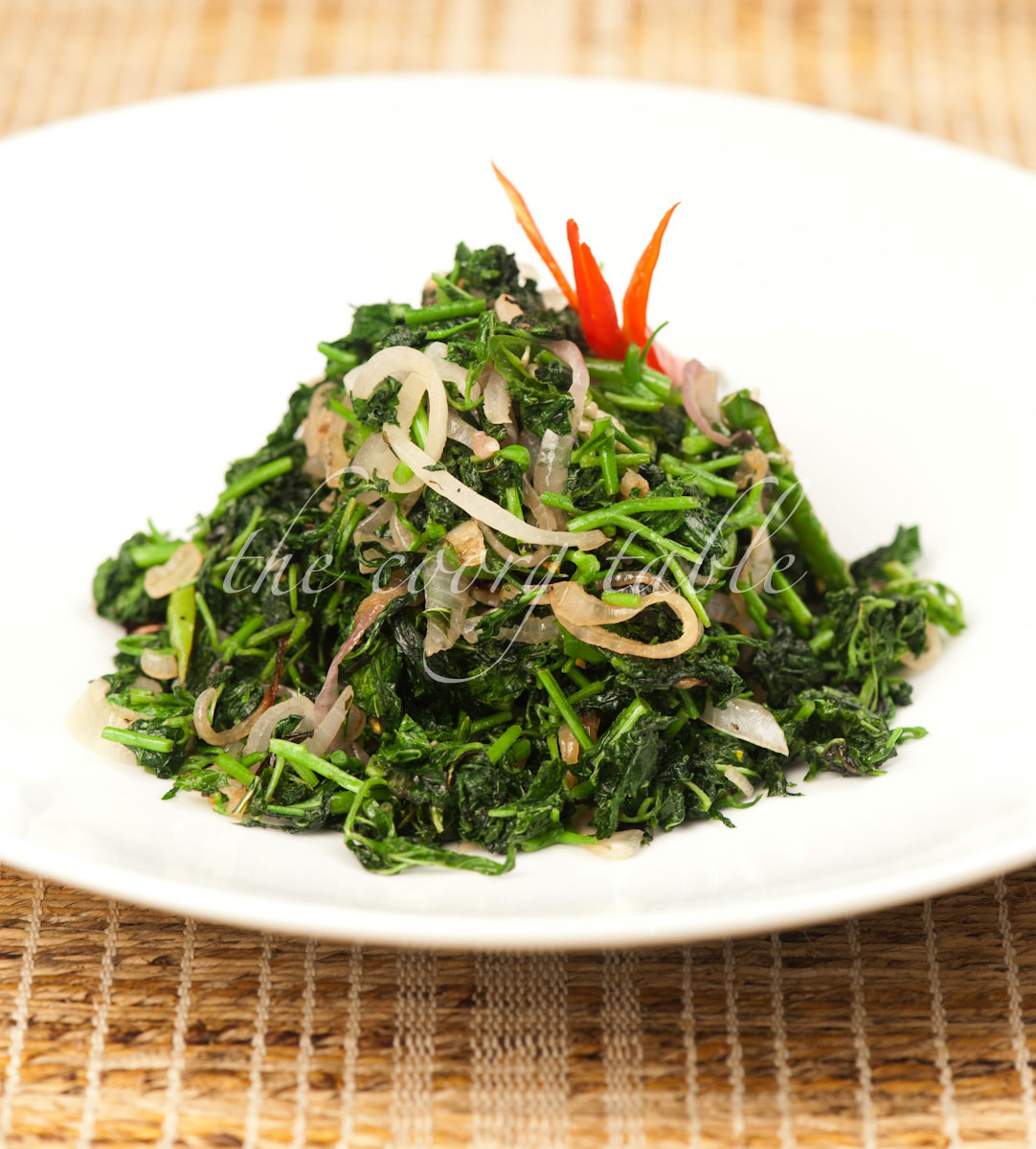 My ancestors were warriors, hunters and farmers. As a people, they were shaped by their surroundings. They knew the secrets of their hills and forests intimately, and hunted regularly until wildlife laws came into place. Venison, wild boar and other game fresh from the hunt, or smoked and dried, were popular; pepper fries of quail, partridge and much more made their way onto the table. The streams were full of fish waiting to be shot, or trapped in ingenious bamboo baskets. The paddy fields yielded small, delicious crabs, and tiny, quicksilver fish. The Coorgs were alert to the nuances of the seasons that brought lavish offerings: exquisite, earth scented wild mushrooms; tender wild greens; colocasia leaves; edible ferns and an abundance of wild fruit and berries. When the monsoon rains obliterated the hills, tender shoots of bamboo emerged from the earth asking to be sliced, fermented, curried and pickled. At this bleak and cold part of the year, the wild shrub, Justicia wynaadensis grew potent with accumulated medicinal properties. Its leaves were gathered, crushed and soaked to extract an exotically scented, deep purple juice, which was boiled with jaggrey and rice to keep everyone fit through the blasts of wind and rain that battered the hills. Meat and fish were carefully dried, smoked, and preserved for these months.
My ancestors were warriors, hunters and farmers. As a people, they were shaped by their surroundings. They knew the secrets of their hills and forests intimately, and hunted regularly until wildlife laws came into place. Venison, wild boar and other game fresh from the hunt, or smoked and dried, were popular; pepper fries of quail, partridge and much more made their way onto the table. The streams were full of fish waiting to be shot, or trapped in ingenious bamboo baskets. The paddy fields yielded small, delicious crabs, and tiny, quicksilver fish. The Coorgs were alert to the nuances of the seasons that brought lavish offerings: exquisite, earth scented wild mushrooms; tender wild greens; colocasia leaves; edible ferns and an abundance of wild fruit and berries. When the monsoon rains obliterated the hills, tender shoots of bamboo emerged from the earth asking to be sliced, fermented, curried and pickled. At this bleak and cold part of the year, the wild shrub, Justicia wynaadensis grew potent with accumulated medicinal properties. Its leaves were gathered, crushed and soaked to extract an exotically scented, deep purple juice, which was boiled with jaggrey and rice to keep everyone fit through the blasts of wind and rain that battered the hills. Meat and fish were carefully dried, smoked, and preserved for these months. 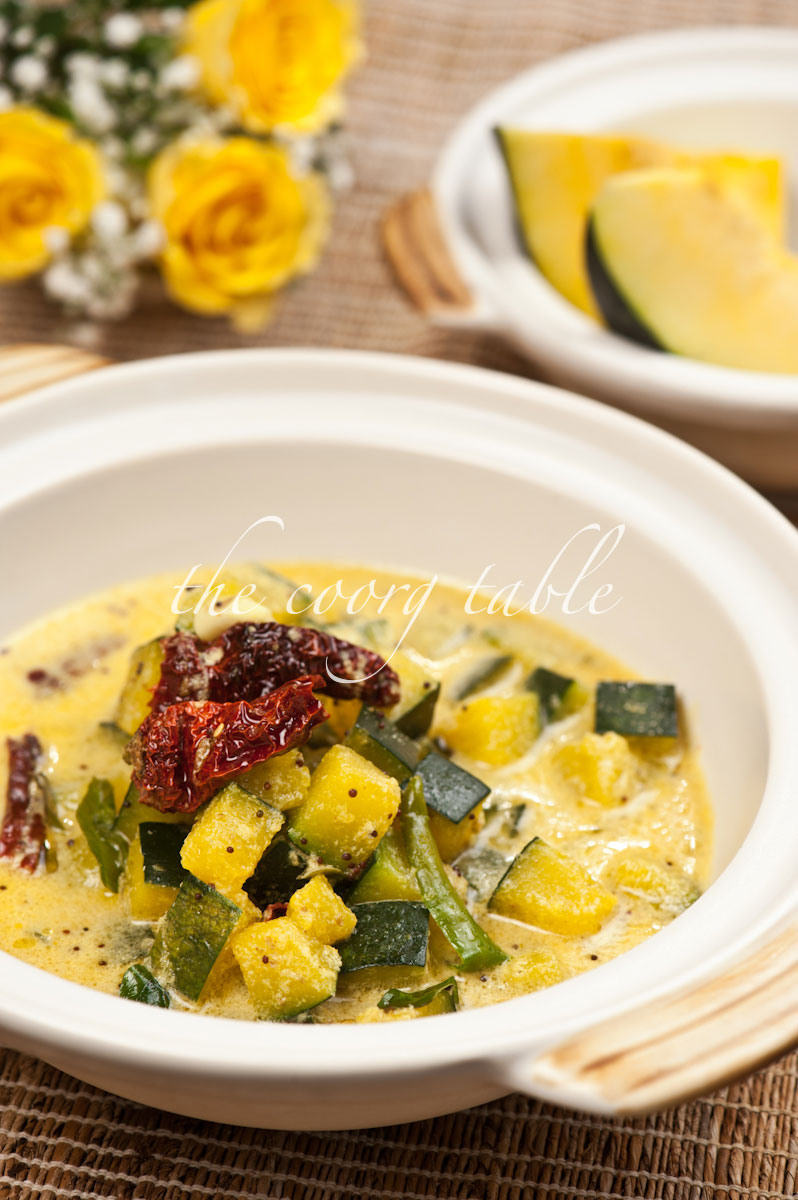 Coorgs grew rice in the rich, wide expanses of the south as well as the steep, terraced fields of the north and, for centuries their caravans wound down the ghats to Malabar to trade sack loads of rice. Rice for them – as it is for us- was never just rice. There’s a charming custom we still follow: when the farmer sees the first sheaves of ripening paddy in the fields, he quietly ties a firm knot in the stalks to prevent the wealth of grain from slipping away, and runs to the granary to reassure it that there is a promise of plenty. In Coorg, we decorate our homes with designs in rice paste, stamped onto walls and pillars with stencils cut out of sections of bitter gourd or, just emphatic palm prints, to welcome the precious new crop of rice. On a cold, clear, night, with a full moon in the sky, we walk to the fields in our bare feet, wearing our ceremonial best, all the men, women and children of the clans, to witness the harvesting of the ripe grain, and carry it back to our ancestral homes. The sacred sheaves will be hung up in the granary, over lit lamps and many other parts of the house, to give thanks and invoke bounty.
Coorgs grew rice in the rich, wide expanses of the south as well as the steep, terraced fields of the north and, for centuries their caravans wound down the ghats to Malabar to trade sack loads of rice. Rice for them – as it is for us- was never just rice. There’s a charming custom we still follow: when the farmer sees the first sheaves of ripening paddy in the fields, he quietly ties a firm knot in the stalks to prevent the wealth of grain from slipping away, and runs to the granary to reassure it that there is a promise of plenty. In Coorg, we decorate our homes with designs in rice paste, stamped onto walls and pillars with stencils cut out of sections of bitter gourd or, just emphatic palm prints, to welcome the precious new crop of rice. On a cold, clear, night, with a full moon in the sky, we walk to the fields in our bare feet, wearing our ceremonial best, all the men, women and children of the clans, to witness the harvesting of the ripe grain, and carry it back to our ancestral homes. The sacred sheaves will be hung up in the granary, over lit lamps and many other parts of the house, to give thanks and invoke bounty. 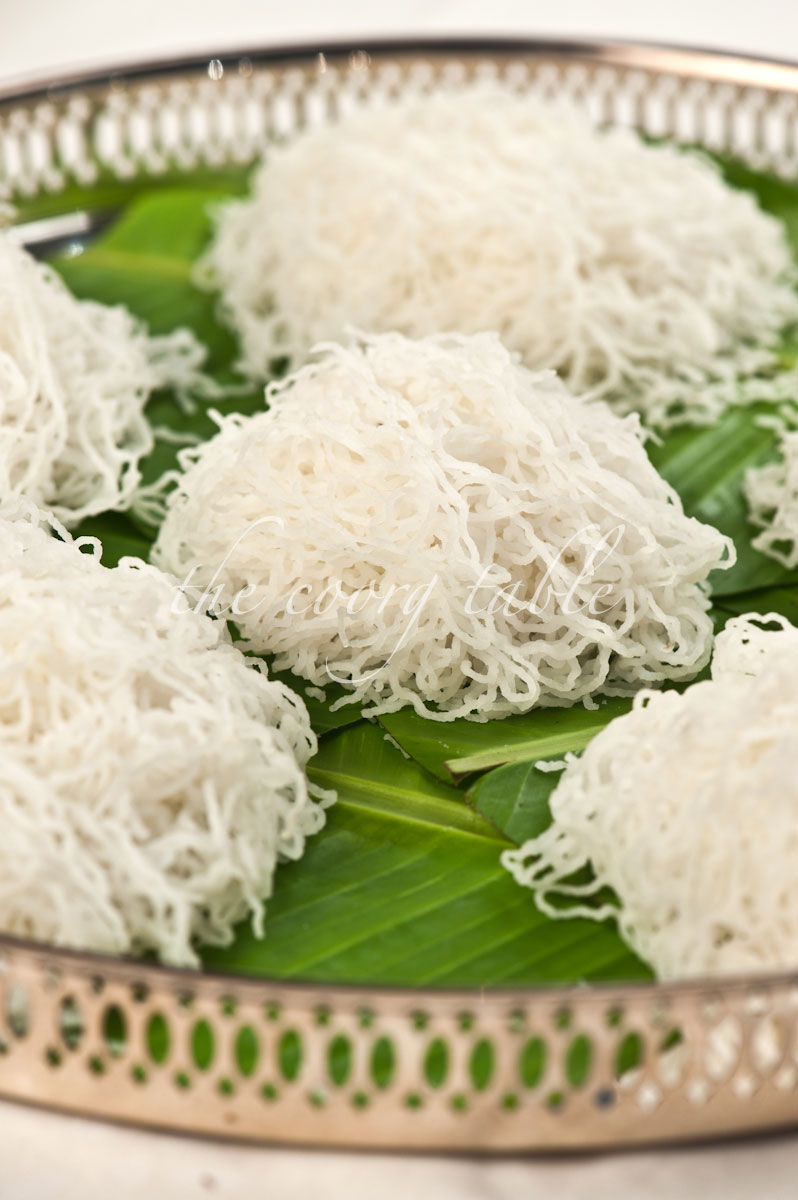 Rice is everywhere in our homes and always on our tables, the link between forest and field. It appears at its simplest, boiled, as gruel, or as the unleavened akki otti. But it is best loved as a puttu: washed, dried and pounded rice is cooked and steamed to create distinctive flavours and shapes, each one carefully paired with a curry. The classic combinations – noolputtu and koli curry, kadambuttus and pandi curry, paaputtu and erachi curry never fail to please. Crab and fish curries are usually eaten with akki ottis or rice. We take these pairings for granted, but they owe everything to uncounted generations of gifted women who worked on the offerings from their surroundings and narrowed the many possibilities down to these combinations of texture and flavour. The creamy, coconut based koli (chicken) curry for instance, goes beautifully with the delicate, thread-like, cardamom-scented strands of noolputtu. The dark, rich gravy of the famous pandi (pork) curry uses the firm texture and neutrality of the round kadambuttu to offset its complex spice combinations. Fish curry is eaten with akki ottis that soak up the tart, spicy gravy. Despite their relative isolation, culinary influences crept in. The rice trade with Malabar brought neyi kool, the lightly sweetened rice coloured with turmeric, cooked in ghee, scattered with raisins and cashew nuts almost certainly influenced by the Mapilahs, and the famous Coorg spicy mutton palav with its accompanying mango raita with hints of garlic.
Rice is everywhere in our homes and always on our tables, the link between forest and field. It appears at its simplest, boiled, as gruel, or as the unleavened akki otti. But it is best loved as a puttu: washed, dried and pounded rice is cooked and steamed to create distinctive flavours and shapes, each one carefully paired with a curry. The classic combinations – noolputtu and koli curry, kadambuttus and pandi curry, paaputtu and erachi curry never fail to please. Crab and fish curries are usually eaten with akki ottis or rice. We take these pairings for granted, but they owe everything to uncounted generations of gifted women who worked on the offerings from their surroundings and narrowed the many possibilities down to these combinations of texture and flavour. The creamy, coconut based koli (chicken) curry for instance, goes beautifully with the delicate, thread-like, cardamom-scented strands of noolputtu. The dark, rich gravy of the famous pandi (pork) curry uses the firm texture and neutrality of the round kadambuttu to offset its complex spice combinations. Fish curry is eaten with akki ottis that soak up the tart, spicy gravy. Despite their relative isolation, culinary influences crept in. The rice trade with Malabar brought neyi kool, the lightly sweetened rice coloured with turmeric, cooked in ghee, scattered with raisins and cashew nuts almost certainly influenced by the Mapilahs, and the famous Coorg spicy mutton palav with its accompanying mango raita with hints of garlic. 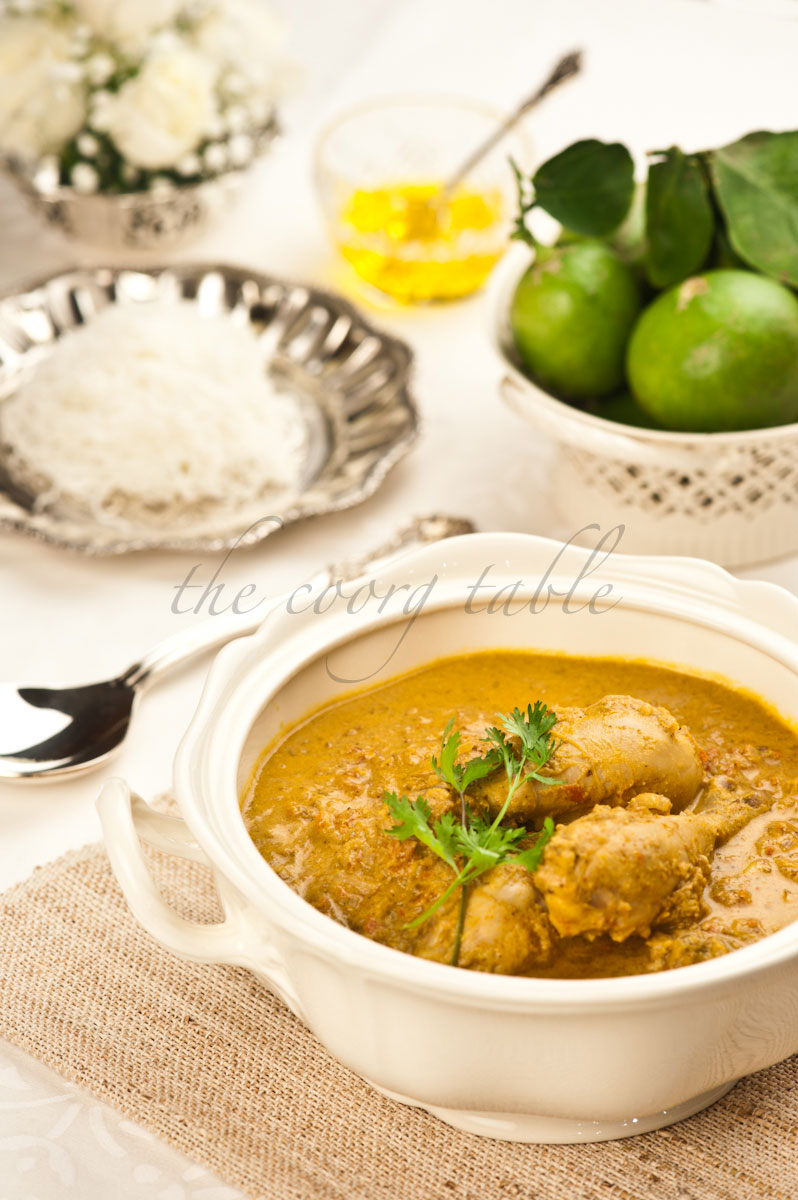 Although Coorgs are always seen to be predominantly meat-eaters, one of their best-kept secrets is the range of fresh, lightly cooked and engaging vegetarian creations. Ranging from simple chutneys of toasted sesame seeds and coconut, roasted and pounded jackfruit seeds, piquant curries of wild mangoes, ash gourd and pumpkins and local French beans, to larger-than-life double beans, garden fresh vegetables are on the table year round, at every meal. Each season brings its own treats: tender colocasia leaves, edible ferns, bamboo shoots and varieties of wild greens, all refreshing, and evocative of the hillsides and riverbanks from where they are collected. In kitchens and attics jars of pickles and preserves hold the cherished tastes of wild hog plums, limes, bamboo shoot and tender jackfruit, salted fish, prawn and pork.
Although Coorgs are always seen to be predominantly meat-eaters, one of their best-kept secrets is the range of fresh, lightly cooked and engaging vegetarian creations. Ranging from simple chutneys of toasted sesame seeds and coconut, roasted and pounded jackfruit seeds, piquant curries of wild mangoes, ash gourd and pumpkins and local French beans, to larger-than-life double beans, garden fresh vegetables are on the table year round, at every meal. Each season brings its own treats: tender colocasia leaves, edible ferns, bamboo shoots and varieties of wild greens, all refreshing, and evocative of the hillsides and riverbanks from where they are collected. In kitchens and attics jars of pickles and preserves hold the cherished tastes of wild hog plums, limes, bamboo shoot and tender jackfruit, salted fish, prawn and pork. 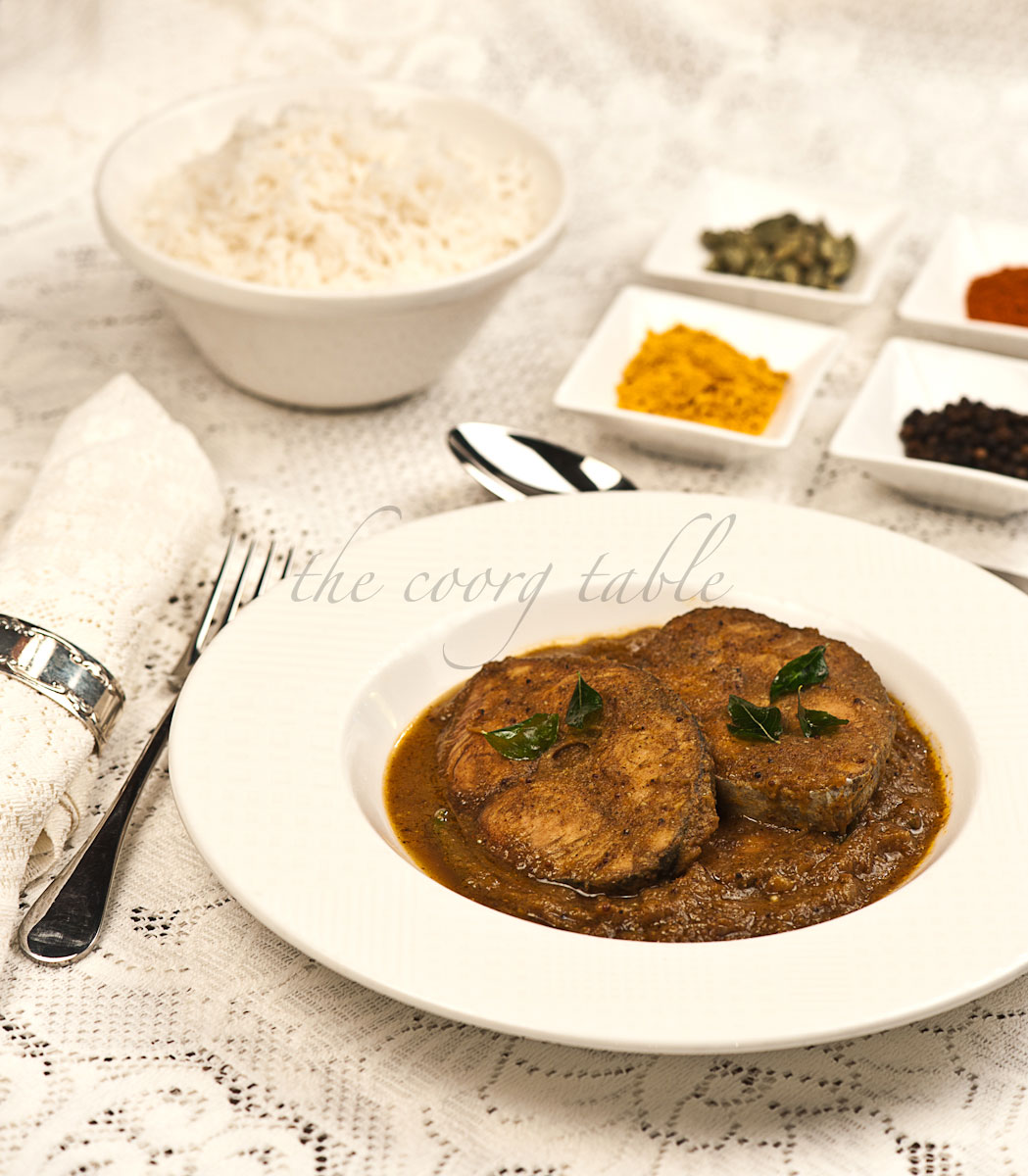 The defining flavour of our traditional cuisine is sourness. Almost every dish has a tang from the dark, sharp vinegar called kachampuli, boiled down from the juices of the fruit of the Garcinia gummi gutta tree. This is the secret ingredient of Coorg cooking, used for fish, chicken, mutton, pork and vegetable fries and curries as a souring and thickening agent. It is used as a marinade, or added in the final stages of a curry, for a dash of tartness thickening it slightly. A squeeze or two of kaipuli (Citrus aurantium), the native marmalade oranges sour enough to make your mouth pucker, or large, juicy, native limes add tangy accents to almost every dish. Dark, dry roasted and powdered spices – peppercorns, cumin, fenugreek and mustard seeds – add another layer of flavour to many preparations. Sesame seed oil, which was the traditional cooking medium brought its own character to every dish. Native strains of pepper and cardamom have grown on the slopes for centuries, familiar and well loved spices that are used generously in the cooking. The prized paringe molu, (Capsicum annum.var. acuminatum) the tiny, explosive bird’s eye chilles that grow in every kitchen garden are the choice for pickling and for smoky roasts and barbecues of wild game.
The defining flavour of our traditional cuisine is sourness. Almost every dish has a tang from the dark, sharp vinegar called kachampuli, boiled down from the juices of the fruit of the Garcinia gummi gutta tree. This is the secret ingredient of Coorg cooking, used for fish, chicken, mutton, pork and vegetable fries and curries as a souring and thickening agent. It is used as a marinade, or added in the final stages of a curry, for a dash of tartness thickening it slightly. A squeeze or two of kaipuli (Citrus aurantium), the native marmalade oranges sour enough to make your mouth pucker, or large, juicy, native limes add tangy accents to almost every dish. Dark, dry roasted and powdered spices – peppercorns, cumin, fenugreek and mustard seeds – add another layer of flavour to many preparations. Sesame seed oil, which was the traditional cooking medium brought its own character to every dish. Native strains of pepper and cardamom have grown on the slopes for centuries, familiar and well loved spices that are used generously in the cooking. The prized paringe molu, (Capsicum annum.var. acuminatum) the tiny, explosive bird’s eye chilles that grow in every kitchen garden are the choice for pickling and for smoky roasts and barbecues of wild game. 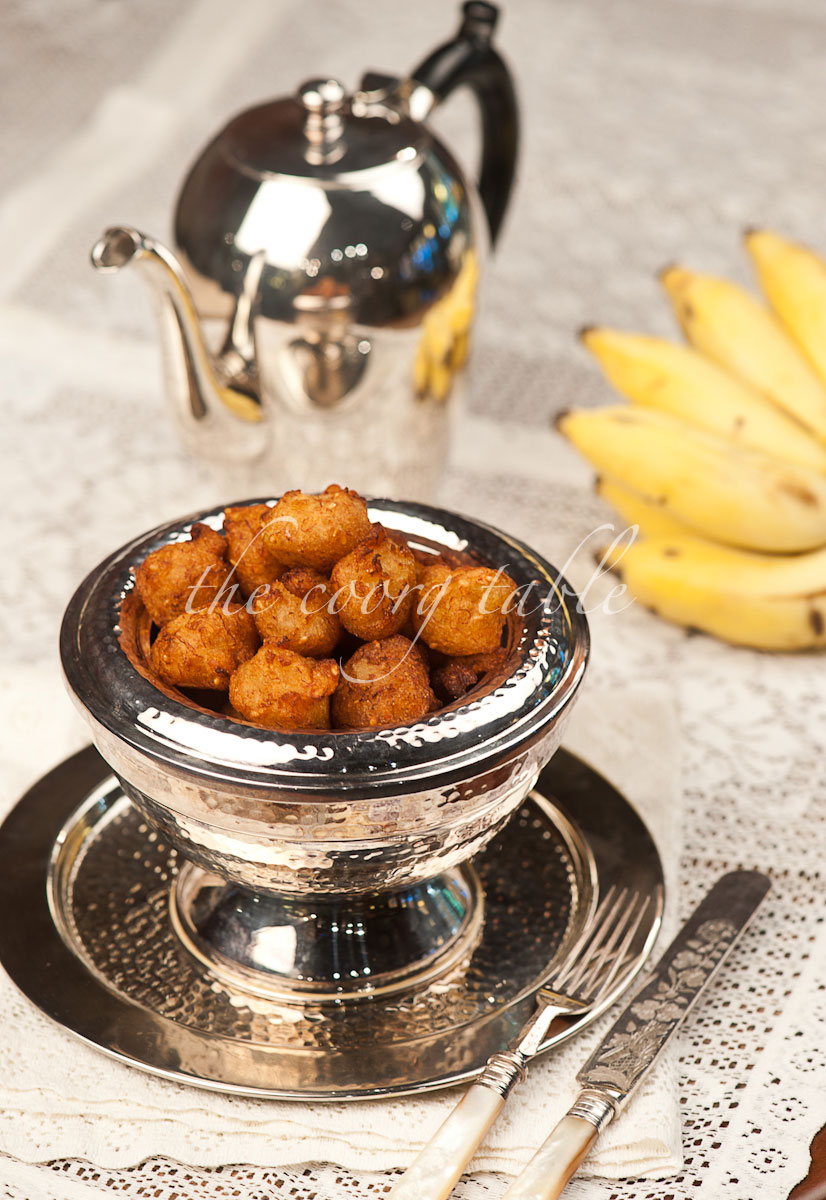 There’s always a reminder of the generosity of the seasons. Fresh fruit – the sweet, loose-jacketed oranges of Coorg, or one of the many varieties of bananas that grow locally usually bring a meal to a close. But if it’s dessert, then rice makes an appearance again. Bale muruku, irresistible banana fritters shot through with toasted sesame seeds, cardamom and shavings of palm jaggery, kneaded with powdered rice are deep fried and served hot; rice payasas are cooked with coconut milk, or poppy seeds; jackfruit pulp mixed with broken rice and steamed in delicately scented koovale leaves into sweet parcels. Modern Coorg has tweaked this inheritance a little, adding a change here and there, refining a dish or a technique; but it has taken generations for the underlying simplicity and perfection of this cuisine to evolve. It’s the perfection of being in step with the seasons; sourcing the freshest ingredients from surroundings and a complete understanding of the produce at hand that would be difficult to improve upon, even if we tried.
There’s always a reminder of the generosity of the seasons. Fresh fruit – the sweet, loose-jacketed oranges of Coorg, or one of the many varieties of bananas that grow locally usually bring a meal to a close. But if it’s dessert, then rice makes an appearance again. Bale muruku, irresistible banana fritters shot through with toasted sesame seeds, cardamom and shavings of palm jaggery, kneaded with powdered rice are deep fried and served hot; rice payasas are cooked with coconut milk, or poppy seeds; jackfruit pulp mixed with broken rice and steamed in delicately scented koovale leaves into sweet parcels. Modern Coorg has tweaked this inheritance a little, adding a change here and there, refining a dish or a technique; but it has taken generations for the underlying simplicity and perfection of this cuisine to evolve. It’s the perfection of being in step with the seasons; sourcing the freshest ingredients from surroundings and a complete understanding of the produce at hand that would be difficult to improve upon, even if we tried. 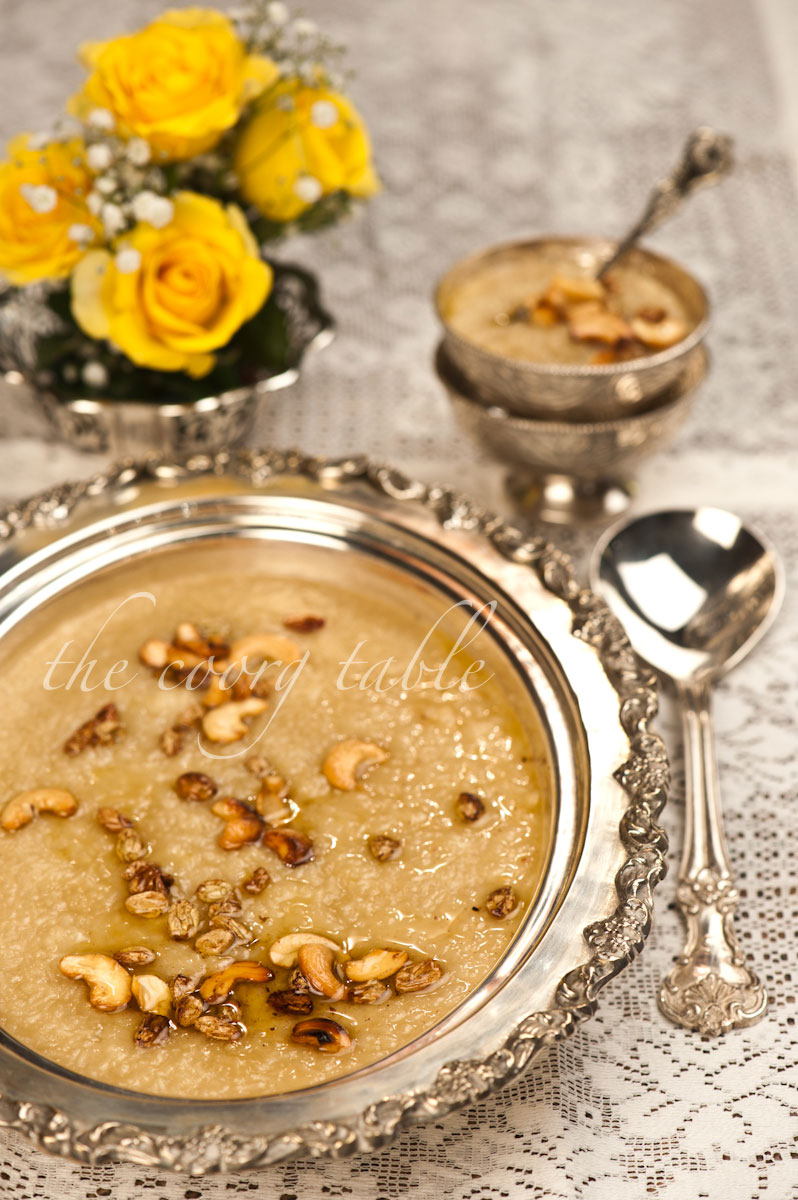
Flavours of Coorg was published in the Taj Magazine, Vol. 40, no.2, 2013.
Photo Credits: Nithin Sagi
All Food Styling: Kaveri Ponnapa
Thank you for visiting this page. If you read something that you enjoy, or see an image that you like, please take a moment to write a response. Do look out for the recipes of all the food featured here in my upcoming cookbook.


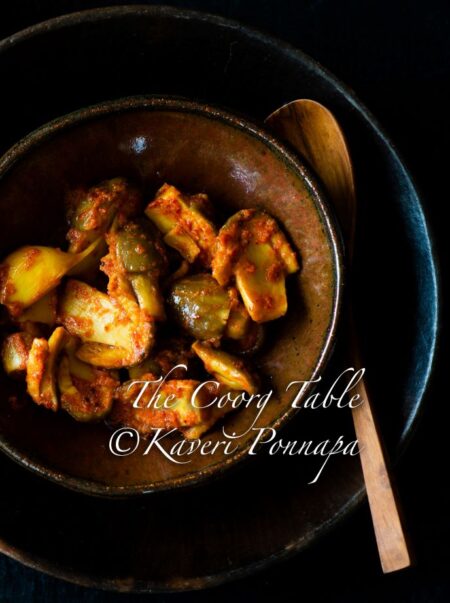


Today came across your blog The Coorg Table……I must say its such a lovely work u have done Mrs. Kaveri Ponnapa….so well written about Coorg and its recipes……God bless and all the best in your endeavours.
Vidya, welcome to The Coorg Table! Thank you very much for writing in, I am so happy that you enjoyed these pages, I value you good wishes. There’s a cookbook on the way that I hope will keep these recipes going for a longer time.I hope you keep visiting the blog, and I would love to hear from you from time to time. Warm wishes.Kaveri
What a lovely informative writeup Kaveri. You bring the hills of Coorg alive through your writing and makes it all so real. God bless you in all your endeavours to preserve and conserve your remarkable heritage. All my love always
Thank you very much,Bridget. It’s a subject I love and have spent many years delving into, so it’s always a joy to write about it. I’m so glad my post brings the place alive for you, that’s all one could hope for. Warmest wishes.Kaveri
great site…could i get to know how to make the onuka erachi that can be stored… and later on fried… i once had the dish in my sisters friends house.. mrs Muthuna .. more than 30 years ago.. please oblige… thank you
Hello, thanks for visiting, please go to this link: where I have a blog on Coorg cuisine. You will find many recipes here and quite a lot about Coorg food traditions.If there is anything in particular that you would like to know, please inbox me : Do read: Best regards.Kaveri